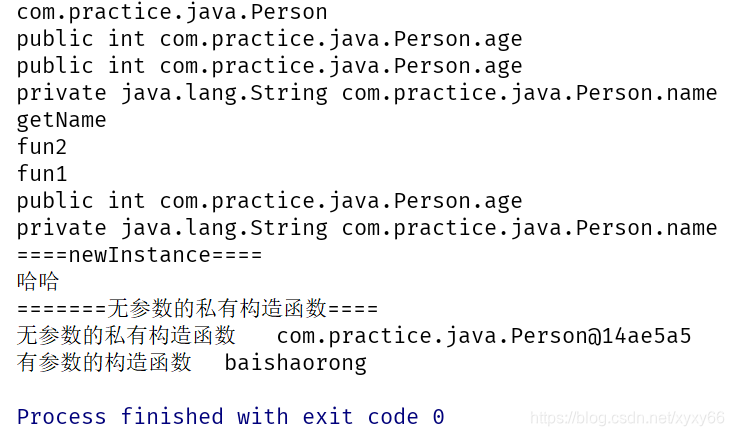参考 :https://blog.csdn.net/sinat_38259539/article/details/71799078
package com.practice.java;
import java.lang.reflect.Constructor;
import java.lang.reflect.Field;
import java.lang.reflect.InvocationTargetException;
import java.lang.reflect.Method;
class Person {
public int age;
private String name;
public Person() {
}
private Person(String name) {
this.name = name;
}
public void fun1() {
System.out.println("Person fun1()");
}
private void fun2() {
System.out.println("Person fun2()");
}
public String getName() {
return this.name;
}
}
public class Reflect {
//首先,必须拿到 Class对象
public static void main(String[] args) throws
ClassNotFoundException, NoSuchFieldException, IllegalAccessException, InstantiationException, NoSuchMethodException, InvocationTargetException {
//1、通过 .getClass() 获取 Class 对象
//Person p1 = new Person();
//Class cl1 = p1.getClass();
//2、通过 类名 .class , 这说明任何一个类都有一个隐含的静态成员变量 class
Class cl2 = Person.class;
//3、通过 Class 的 forName() 静态方法来获取,用的最多,但可能抛出 ClassNotFoundException 异常
//Class cl3 = Class.forName("Person");
//System.out.println(cl1 == cl2);
//System.out.println(cl2 == cl3);
//System.out.println(cl1 == cl3);
/**
* 面试问题:
* Class对象的个数?
* 2、三个最重要的类型?
*Field Method Constructor
* newInstance;
*/
//得到类名
String classname = cl2.getName();
System.out.println(classname);
//获取类的 public 属性
Field[] fields = cl2.getFields();
for(Field fields1 : fields){
System.out.println(fields1);
}
//获取类的所有属性 包括私有属性
Field[] field = cl2.getDeclaredFields();
for(Field fields1 : field){
System.out.println(fields1);
}
//获得类的所有方法
Method[] methonds = cl2.getDeclaredMethods();
for(Method methond : methonds){
System.out.println(methond.getName());
}
//获取指定的属性public
Field f1 = cl2.getField("age");
System.out.println(f1);
//获取private私有属性
Field f2 = cl2.getDeclaredField("name");//抛出异常
System.out.println(f2);
//启用和禁用访问安全检查的开关,值为 true,
//则表示反射的对象在使用时应该取消 java 语言的访问检查;反之不取消
f2.setAccessible(true);
System.out.println("====newInstance====");
Person p2 = (Person)(cl2.newInstance());//抛出异常
Person p3 = (Person)(cl2.newInstance());
f2.set(p2,"哈哈");
System.out.println(f2.get(p2));
System.out.println("=======无参数的私有构造函数====");
Constructor c1=cl2.getDeclaredConstructor();
c1.setAccessible(true);
Person p1=(Person)c1.newInstance();
System.out.println("无参数的私有构造函数\t"+p1);
//得到带有一个参数的私有构造函数
Constructor c2 = cl2.getDeclaredConstructor(String.class);
c2.setAccessible(true);
Person person = (Person)c2.newInstance("baishaorong");
System.out.println("有参数的构造函数\t"+person.getName());
}
}
打印结果:
